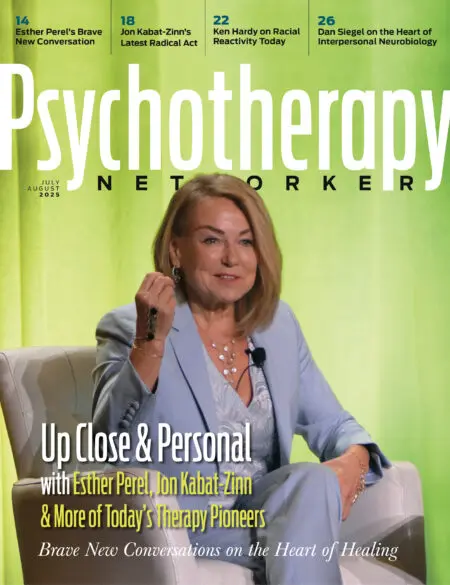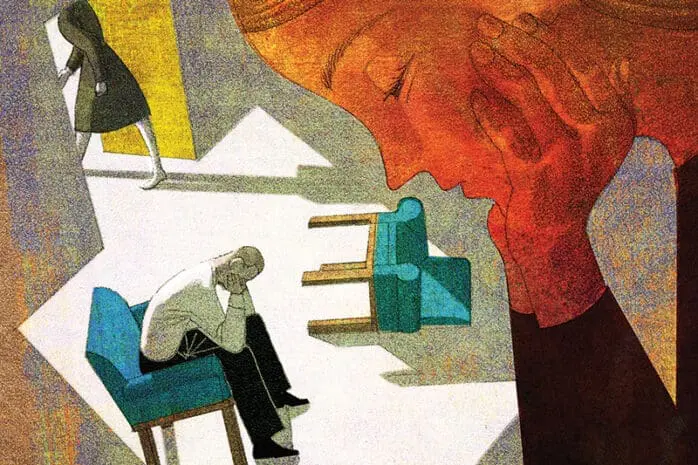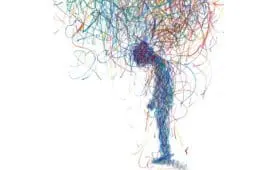
The Therapist's Craft
Challenges on the path to therapeutic connection, creativity, and healingCan AI Make Us Better Therapists?
Using New Technology for SupervisionWork Issues at the Heart of Couples' Conflicts
Exploring Our Relationships with Our JobsSaying Goodbye to Work You Love
How Do Therapists Know When It's Time to Retire?Releasing Guilt in Grief
The Vital Shift from Prevention to PostventionShame and Blame in Couples Therapy
A Therapist's Misstep Sparks RepairRethinking Codependence
An Attachment-Based Framework for CaregiversKen Hardy on Racial Reactivity Today
A Clinical Tool for Navigating Defensiveness, Anger & HopelessnessKen Hardy has been presenting workshops on racial reactivity for over 30 years. What's different now? Read more
The Vulnerability Junkie
A Fresh Look at the Pursuer-Distancer DynamicWe're all familiar with the pursuer-distancer dynamic, but are therapists missing the mark when it comes to helping withdrawers connect? George Faller thinks... Read more
Embodied Healing in a Disembodied World
Metabolizing Intergenerational Trauma & Collective GriefLinda Thai takes a holistic approach to healing from trauma, addiction, and attachment wounding—one that includes reverence for our bodies, nature, and time... Read more
When Grief Is a Soft, Grey Animal
Megan Devine & Leanne Campbell Reveal Unlikely Paths to HealingGrief expert Megan Devine & EFT trainer Leanne Campbell help a relationally fulfilled, successful, father-to-be explore his persistent grief over the loss of... Read more
Flip Through the Magazine!
Brave New Conversations on the Heart of HealingExperience some of the most meaningful moments that happened at Psychotherapy Networker’s annual Symposium in 2025, with some of the premiere thought leaders... Read more
IFS Made Simple for Clients
Moving From "What's Wrong with Me?" To "What Do I Need?"IFS becomes more accessible when we translate psychological jargon into universal experiences of need and care. Read more
Baseline Suicidality in Neurodivergent Kids
Misunderstanding Sensory and Emotional ChaosIn misdiagnosed neurodivergent teens, suicidality may not be indicators of a desire to die but of misunderstood sensory and emotional chaos. Read more
Answers to Therapy's Big, Slippery Questions
What Has Our Field Forgotten?Tara Brach, Irvin Yalom, Eugene Gendlin, and Daniel Kahneman share answers to some of the biggest, most slippery questions therapists face. Read more
How Do We Change Bad Habits?
Getting to Know Our Mental MachineryDaniel Kahneman, bestselling author of "Thinking Fast and Slow," explores how therapists can help clients change bad habits that cause misery. Read more
When Memories Get in the Way
Unlearning the Truths We Tell OurselvesSometimes a client's memory may be a red herring that keeps us from focusing on what’s really important: what’s happening in the here and now. Read more
Dive into the Digital Magazine!
The Hidden Dangers to Your PracticePsychotherapy Networker has won awards not only for its insightful articles, but for its beautiful design. Want to flip through the pages of the latest issue? Read more
The Case of the Late Client
Janina Fisher & Gabor Maté Tackle a Clinical ChallengeTwo renowned experts show you how they’d work with the same client in Psychotherapy Networker’s version of The Gloria Tapes. Read more
Medical Professionals Need Intensive Care
When Feelings are Seen as a Job HazardHow can therapists help medical professionals process difficult experiences when their profession demands stoicism and invulnerability? Read more
Starting a Coaching Practice
The Benefits of Therapists Opening a Side BusinessFor burnt-out therapists, opening a coaching business in the right way and for the right reasons can be a reinvigorating side-gig. Read more
So You Wanna Be a Life Coach?
The Legal & Ethical Risks to Your Therapy PracticeMore and more therapists are using life coaching as a workaround to the challenges of cross-state practice—but doing so can have serious consequences. Read more
Are Supervisors Failing the Field?
Why Minoritized Supervisees Are LeavingToo many minoritized supervisees are leaving the field. How do we hold on to them? Read more
Defusing Couples Conflicts with the Enneagram
A New Take on a Centuries-Old ToolBy making sense of one another’s temperamental styles through an Enneagram lens, therapists can help partners understand their differences in a new way. Read more
The Orgasm Gap
7 Strategies to Help Women Experience Sexual PleasureMany women struggle with orgasm in heterosexual relationships. Here are seven strategies therapists can use to empower female clients to experience more... Read more
The Myth of the Perfect Parent
Helping Clients Overcome Shame and Accept ImperfectionWe all know that there’s no such thing as a “perfect” parent, but even so, many parents hold themselves to unreasonably high standards. Read more
Dive into the Digital Magazine!
The New AutismPsychotherapy Networker has won awards not only for its insightful articles, but for its beautiful design. Want to flip through the pages of the latest issue... Read more
The Therapist Who Sees Therapists
Working with the Trickiest ClientsIt’s no secret: therapists make tricky clients—but there are specific ways we can help therapist-clients feel seen and cared for. Read more
Is Therapy Slipping into Pseudoscience?
Recognizing the Warning SignsAre we doing enough as clinicians—and as a field—to ensure we’re using truly science-based treatments? Read more
Unlearning Behaviorism
The Mindshift of PDA-Informed CareTried-and-true behavioral strategies have been failing spectacularly in households with Pathologically Demand Avoidant children. Helping PDA families feel safe... Read more
Inside The PDA Safe Circle
Supporting Vulnerable Nervous Systems in Chronic DistressVulnerable nervous systems that are in chronic distress require a unique approach to understanding and creating a felt sense of safety. Read more
Healing a Lifetime of Neurodivergent Trauma
Accommodation, Validation, and Autistic AttunementFor many Autistic people, the trauma they carry is a result of society treating them like broken neurotypicals. Neuro-affirming care begins with providing... Read more
What Not to Do in Neuro-Affirming Intakes
And What You Should Always DoNeuro-affirming intakes need to begin with doing no harm. Read more
Autism and Disordered Eating
What You May Be Missing and MisdiagnosingThe overlap between autism and eating disorders is poorly understood, even by many eating disorder specialists. Read more
The PDA Lens
A New Vision for Supporting a Nervous System DisabilityWhat would you do if your active but chronically dysregulated four-year-old stopped speaking, eating, and moving, and everyone you turned to for... Read more
Neurodiverse Couples Therapy
The Truth about Relationships through a Neurospicy LensCouples therapy was designed for neurotypical people—yet we know that neurodivergence is everywhere. How can we better identify, help, and support... Read more
Today's Autism and Teens
Grappling with Identity, Belonging, and Self-AcceptanceWhen it comes to teens who’ve found belonging and understanding in the autism community, our job is more about validating than diagnosing. Read more







































